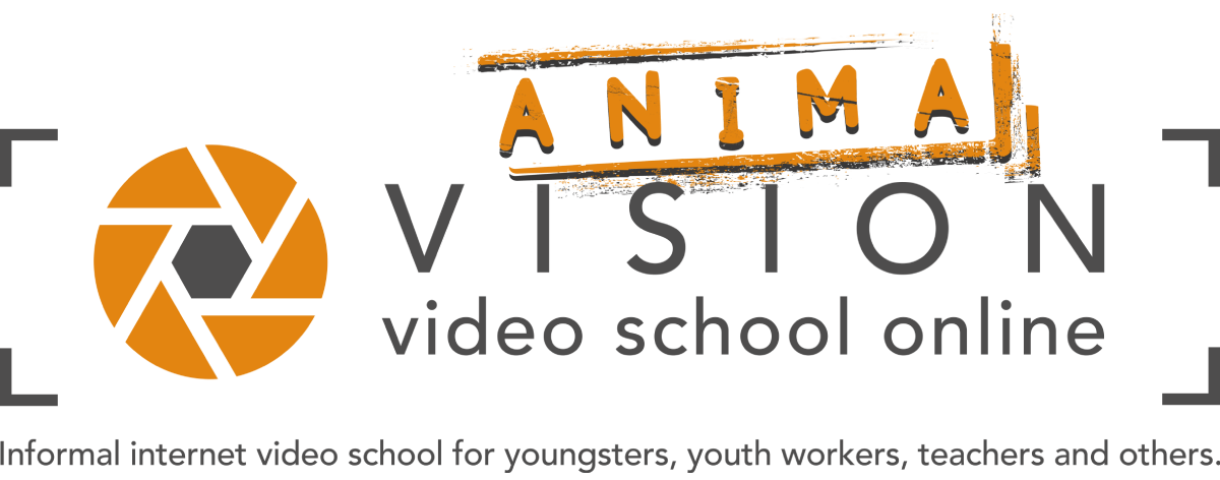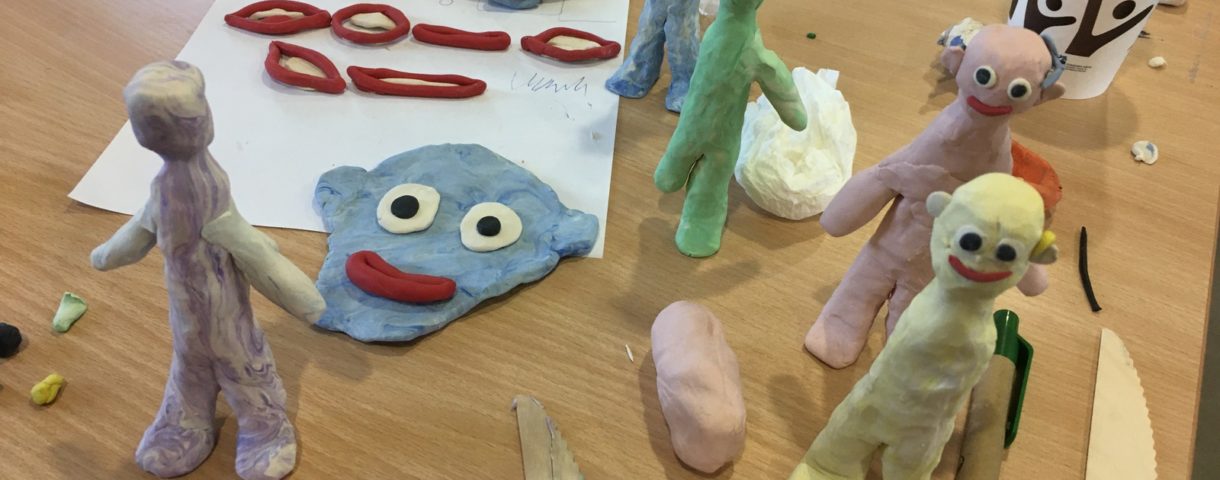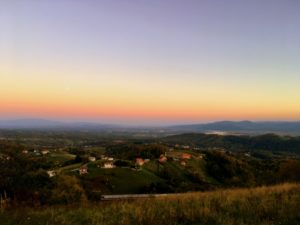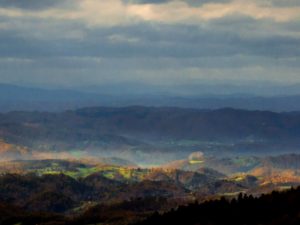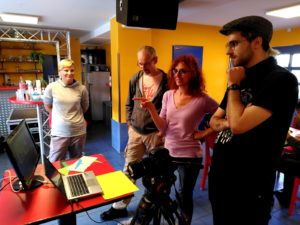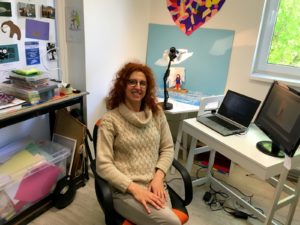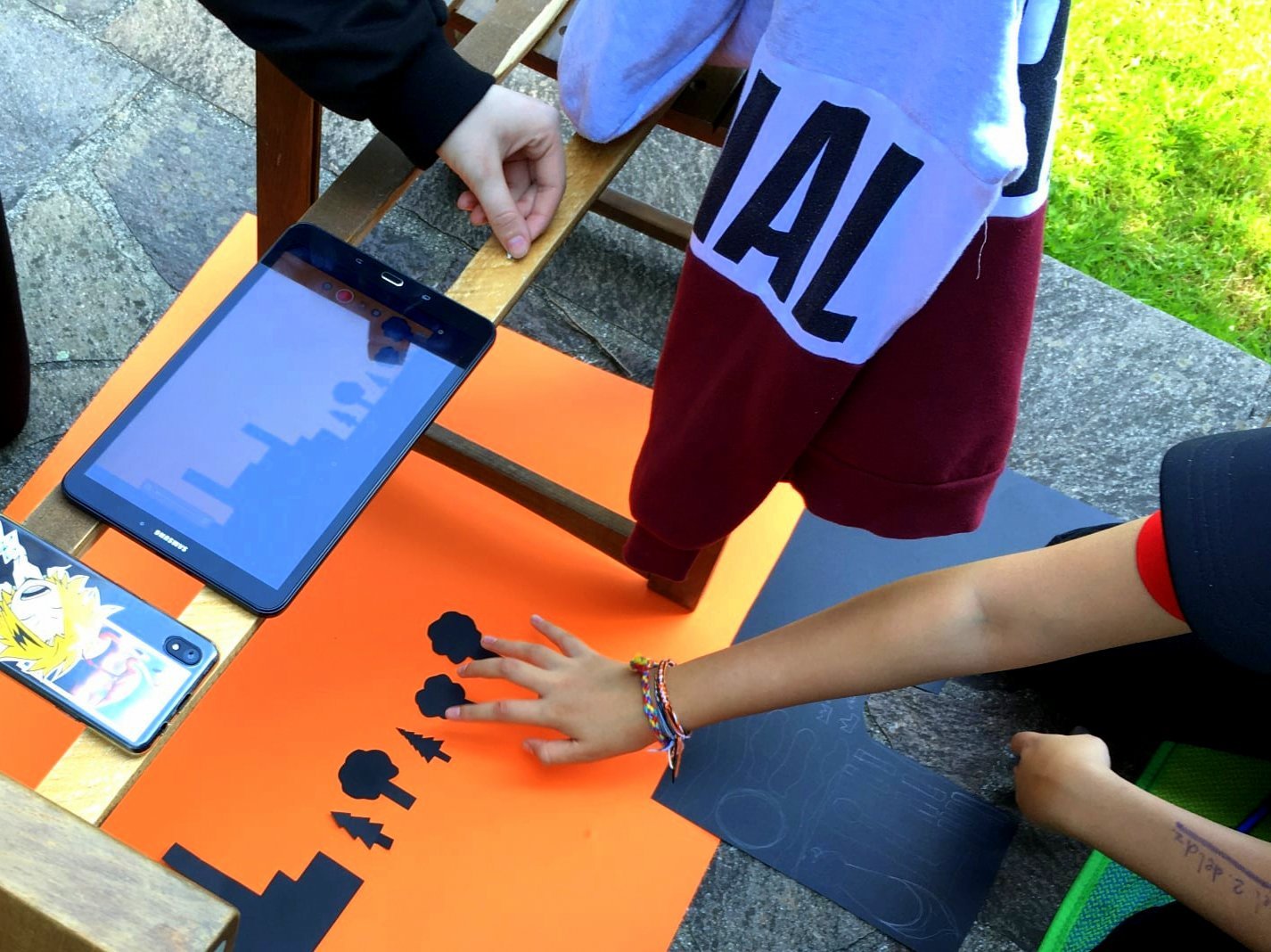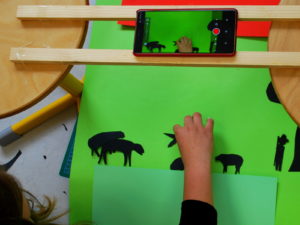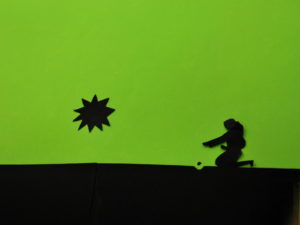This chapter is special in the Vision and Animavision videoschool. Its purpose is to collect and share stories from different youth workers from different countries in which they share their experience and useful practices on how to include young people with less opportunities in the youth work. The chapter contains mostly stories from multimedia projects with young people but if you are a youth worker or interested in youth work, you can also get a glimpse into different youth work practices and benefit from the experiences and ideas.
We hope these stories will inspire you and you are completely free to use presented methods in your work.
Motivating Young People with Less Opportunities Through Animation and Some Advices
Ramazan DERİN, Turkey
I am a teacher and have started my career 13 years ago. So far, I have worked in different schools in different cities. At the beginning of my career, I worked in both primary and secondary schools and most of my students were under 14 years old. Then, in 2014, I started working at the project office of the Balıkesir Governorate. I have worked there for 3 years. During these 3 years, the office carried out projects on different topics. We also did some projects about young people.
These projects were: Discover your entrepreneurship through questioning and Youth in Parliament. Sometimes I also participated in some youth projects and trainings for youth workers. These were: Scene for Unity and Be Social! Be Entrepreneur. So I can say that this period was my first contact with youth and youth projects. In short, I have been working with young people both at school and in projects for the past 7 years.
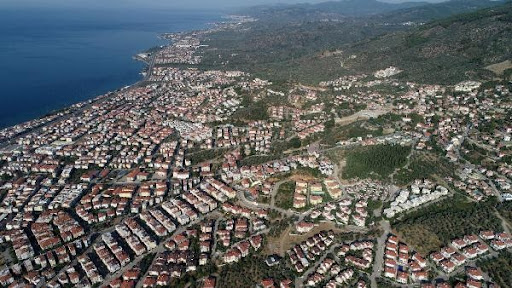 I live in Edremit and moved to this city in 2018. It is located near the Aegean Sea and is one of the most popular tourist cities in the west of Turkey. It also has natural beauties. For these reasons, the city attracts many people to live and work here. During the summer months, the population increases greatly due to tourism, so the city offers many job opportunities. Retired people also prefer to live in this city and move here. In addition, some people who work and live in big cities near Edremit move here because they want to live in a smaller, quieter and more natural place. All these people who want to move and live in the city increase the demand for houses, and for this reason the construction sector in Edremit is very busy. So, the sector needs a lot of workers. And in turn, many people come here to work and live with their families. As a res
I live in Edremit and moved to this city in 2018. It is located near the Aegean Sea and is one of the most popular tourist cities in the west of Turkey. It also has natural beauties. For these reasons, the city attracts many people to live and work here. During the summer months, the population increases greatly due to tourism, so the city offers many job opportunities. Retired people also prefer to live in this city and move here. In addition, some people who work and live in big cities near Edremit move here because they want to live in a smaller, quieter and more natural place. All these people who want to move and live in the city increase the demand for houses, and for this reason the construction sector in Edremit is very busy. So, the sector needs a lot of workers. And in turn, many people come here to work and live with their families. As a res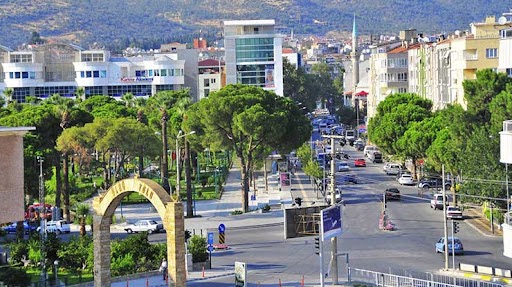 ult of these factors, the people living in the city have different social and economic backgrounds. There are people in the city from all around the country.
ult of these factors, the people living in the city have different social and economic backgrounds. There are people in the city from all around the country.
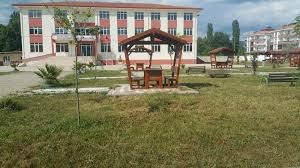 Our school is located in Akçay, one of the touristic neighbourhoods of the city. And there are a lot of construction workers with their families and divorced families in the area that our school is located. The students from different neighborhoods, which are generally disadvantaged, also come to our school to study. Because of their social and economical status and families, their exam scores are not good enough to study in a better high school. In Turkey, at the end of secondary school, the students take an exam to be able to study in a good high school. And our school’s students are the ones who could not pass that exam. And most of their grade-point averages from secondary school are low. These also show us that there were problems which our students experienced and something went wrong in their previous education life before they came to our school.
Our school is located in Akçay, one of the touristic neighbourhoods of the city. And there are a lot of construction workers with their families and divorced families in the area that our school is located. The students from different neighborhoods, which are generally disadvantaged, also come to our school to study. Because of their social and economical status and families, their exam scores are not good enough to study in a better high school. In Turkey, at the end of secondary school, the students take an exam to be able to study in a good high school. And our school’s students are the ones who could not pass that exam. And most of their grade-point averages from secondary school are low. These also show us that there were problems which our students experienced and something went wrong in their previous education life before they came to our school.
We have many students whose fathers work in the construction sector. And their families’ economical, social and educational level is poor. Most of them emigrate to Edremit from rural areas or the east part of Turkey for a better life. And all these people have different cultural backgrounds and they sometimes have problems adapting to society. The other problem is that we have an considerably high number of students whose parents are divorced. And, unfortunately, some of these students have to live in their relatives’ houses as both their fathers and mothers refuse to get their custody. The parents may do this as a way to punish each other. But everything affects the children in the end. Imagine that you don’t have your own room, house and the family anymore and you have to live in another place! In addition, students, whose parents are divorced, often feel lonely or introverted and shy because their parents cannot communicate with them in a healthy and regular manner. Sometimes, on the contrary, they are in an aggressive mood. During the pandemic period, these students were even more alone and negatively affected by this process. Again, because the divorced families do not take care of their children properly and keep them busy only with technological tools such as mobile phone, tablets or computers, the motor skills of these students (cutting, pasting, shaping something) have not developed enough. Additionally, we observe that there is a lack of motivation in our students in general.
They are neither enthusiastic about lessons nor about extracurricular activities. They are either very impatient, or do not want to do anything at all. As you see, most of our students can be regarded as disadvantaged and most of them have more problems than they should. They have less opportunities compared to their peers. And because of these reasons we try to help these students by promoting their social inclusion and trying to give equal chances.
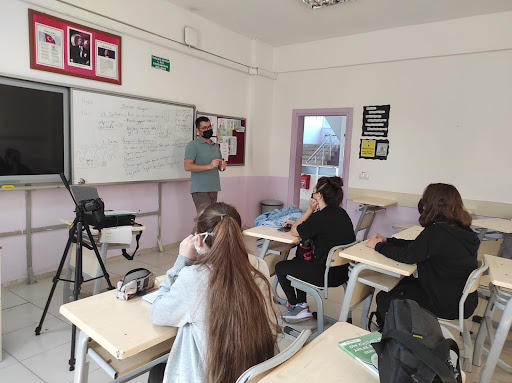 I have been working in this school and area/neighbourhood since 2018 and I try to help our students and all other students with the problems I mentioned above through various projects. These projects are usually Erasmus + projects. Thanks to these projects, our students can take part in many activities and become more socialized and included in a group. Sometimes, students with bad grades can experience the feeling of achieving something and being appreciated by taking part in these project activities. This motivates them more for the future. We are running a school partnership and a youth project in our school.
I have been working in this school and area/neighbourhood since 2018 and I try to help our students and all other students with the problems I mentioned above through various projects. These projects are usually Erasmus + projects. Thanks to these projects, our students can take part in many activities and become more socialized and included in a group. Sometimes, students with bad grades can experience the feeling of achieving something and being appreciated by taking part in these project activities. This motivates them more for the future. We are running a school partnership and a youth project in our school.
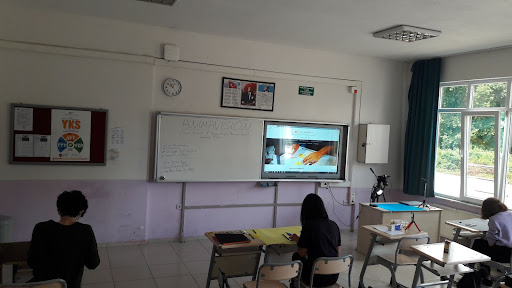 Thanks to our youth project Animavision, we are able to offer our students with less opportunities a chance to socialize and express themselves in a different way. In the project, we make animation films and videos with the students, taking photos and using the stop-motion technique. I have already had a personal interest in taking photos before and had acquired some basic knowledge about it. Thanks to this project, I had a chance to use my experiences. Of course, since I have never done stop-motion animation before, I gained a lot of new knowledge and experience. Especially during our testings/workshops with our disadvantaged students, we gained some experience on how we can increase their motivation and improve their missing points.
Thanks to our youth project Animavision, we are able to offer our students with less opportunities a chance to socialize and express themselves in a different way. In the project, we make animation films and videos with the students, taking photos and using the stop-motion technique. I have already had a personal interest in taking photos before and had acquired some basic knowledge about it. Thanks to this project, I had a chance to use my experiences. Of course, since I have never done stop-motion animation before, I gained a lot of new knowledge and experience. Especially during our testings/workshops with our disadvantaged students, we gained some experience on how we can increase their motivation and improve their missing points.
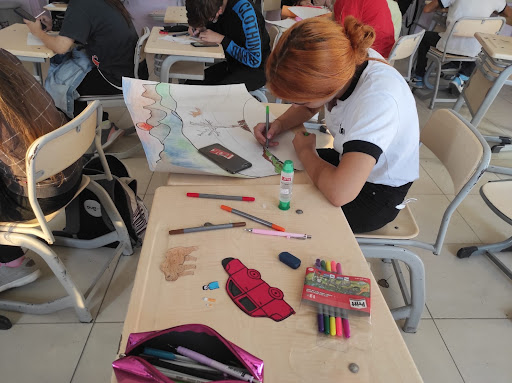 For example, we assigned students with weak motor skills (such as cutting and pasting) to prepare the scene and characters to be used in the animated movie and appreciated their work. In order to increase their motivation, we worked by having more frequent breaks instead of very long working hours. During these breaks, quiet music can be played and drinks such as tea, coffee and small snacks can be enjoyed. This will help them feel more comfortable in this environment. It also helps to make the work environment comfortable and interesting for their motivation.
For example, we assigned students with weak motor skills (such as cutting and pasting) to prepare the scene and characters to be used in the animated movie and appreciated their work. In order to increase their motivation, we worked by having more frequent breaks instead of very long working hours. During these breaks, quiet music can be played and drinks such as tea, coffee and small snacks can be enjoyed. This will help them feel more comfortable in this environment. It also helps to make the work environment comfortable and interesting for their motivation.
Working in different environments from time to time also has a positive effect on the motivation of young people. And don’t forget that the stop-motion animations that they filmed will be shared on some online platforms (YouTube, Facebook, Instagram, etc.) to show these videos to their friends, families and project partners. This also motivates them as today’s youth care about creating and sharing content like this on social media.
Filmmaking technics with young people
Sertan AY, Turkey
 I am 42 years old and I have been working as a teacher for about 19 years. I am always in contact with young people in my business and routine life. I have been involved in many youth activities not only in school but also outside of school life. I have always worked in high schools. I am actively working on projects and studies in several youth associations.
I am 42 years old and I have been working as a teacher for about 19 years. I am always in contact with young people in my business and routine life. I have been involved in many youth activities not only in school but also outside of school life. I have always worked in high schools. I am actively working on projects and studies in several youth associations.
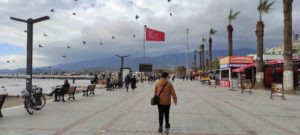 We live in Edremit, the western part of Turkey. Our region is very rich in terms of natural beauties, economy and social life. Because of these features, it receives a lot of immigration. People from different cultures come to our region to live. For tourism purposes, there is a large crowd of people in summer seasons. This density of people also brings with it many problems. If I summarize the challenges regarding young people, they would be as follows:
We live in Edremit, the western part of Turkey. Our region is very rich in terms of natural beauties, economy and social life. Because of these features, it receives a lot of immigration. People from different cultures come to our region to live. For tourism purposes, there is a large crowd of people in summer seasons. This density of people also brings with it many problems. If I summarize the challenges regarding young people, they would be as follows:
- Many young people come from the east of Turkey and find it difficult to adapt to the cultural characteristics of western Turkey.
- There are many young people who suffer from economic difficulties.
- Many young people have a refugee or migration background.
- There are young people who are Roma or Sinti. On the one hand, they experience discrimination from the majority society and at the same time they have problems adapting.
- There are many children of divorce and also some pupils who live with their grandparents.
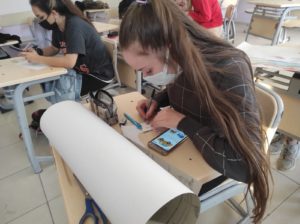 The first thing that young people who come to our region from the east complain about, is not being able to make friends. If we add to this the effects of pandemic problems, there is a serious social loneliness. In addition, children coming from divorced families also have a lack of self-confidence. These children find it difficult to be included in groups. I am working in a high school. We can follow all the situations and problems of our students through the E-School system. Counseling service also gives us information about students‘ problems.
The first thing that young people who come to our region from the east complain about, is not being able to make friends. If we add to this the effects of pandemic problems, there is a serious social loneliness. In addition, children coming from divorced families also have a lack of self-confidence. These children find it difficult to be included in groups. I am working in a high school. We can follow all the situations and problems of our students through the E-School system. Counseling service also gives us information about students‘ problems.
We made student project groups in our school. We invite students who are in some disadvantaged situations to these groups. The students whom we invited to the project groups were hesitant at first, but later they haven’t had any problems in adapting to the groups, they are happy in this comfortable and fun atmosphere. We also get official permission from the parents for these students.
We shoot stop-motion videos on subjects which we decide with students. Our project is about videos and there are foreign partners in the project so this increases the interest of our students. The students have an opportunity to be included in a social group and to work with their friends, which makes them very happy. It is impossible for our students to create such an environment on their own. It is also very difficult to do such a study with the resources of our school itself. However, with the project, students can participate in the studies much more easily.
Edremit Region is one of the regions that face many different problems and has the highest population growth in Turkey. This growth and confusion also changes family structures in social life and disrupts relationships. However, this uncontrolled growth has also affected the rural life quite a lot.
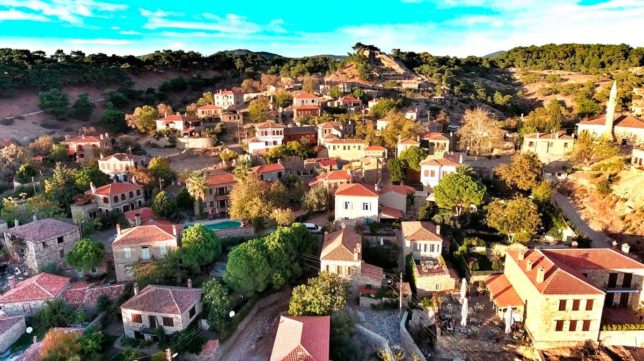 There are many young people living in villages in the Kazdağları region of our district. Students come to our school from these villages. There are young people from different backgrounds and cultures in our school. There also are a considerable number of children with single parents in our area. In some classes, this rate reaches up to 1 in 3. We want to support these students and help them socialize more. These students who have family problems may feel incomplete in school and social life. They try to hide their negative situations and often avoid other people.
There are many young people living in villages in the Kazdağları region of our district. Students come to our school from these villages. There are young people from different backgrounds and cultures in our school. There also are a considerable number of children with single parents in our area. In some classes, this rate reaches up to 1 in 3. We want to support these students and help them socialize more. These students who have family problems may feel incomplete in school and social life. They try to hide their negative situations and often avoid other people.
If I talk about myself; I love doing projects and working with young people. I have been working in high school since 2003. During this time, I have gained many different experiences. I have given courses in adult education institutions. I worked as a youth leader in some youth associations. I have worked as a project coordinator at the District Directorate of National Education. I took part in dozens of Erasmus+ projects.
I am constantly improving myself and sharing my experiences and energy with young people. Since I started teaching, I have been interested in technology, video and photography. I do web design, I have some websites. I love shooting short films and making short films in my spare time. I have been photographing and archiving for years. I took part in the first steps of this project before. I have done some workshops on video designs to youth groups in our youth association. I have a social media page which I use to promote Edremit District and I share photos and videos about Edremit. I also take photos and videos of our school and I edit and run our school’s website and social media accounts.
This project taught me many different techniques and ideas. We do all these activities together with our youth groups from our school. Young people are very demanding. Today, the rapid progress of technology and the importance of social media among young people increase the importance of our project. Video content can reach a wide audience instantly. A short video can be more effective than pages of text. Young people know the importance of producing video content, so they take care of our project.
Introducing filmmaking to young people in rural areas
Mia Brunej, Slovenia
It has been around 20 years since I’ve started working with young people in our region. First shortly in an NGO focusing on discussion groups on various topics in local primary schools but soon after that as a mentor in different multimedia projects that started parallel with my learning of filmmaking.
Firstly let me explain a bit more about the region Posavje where I come from. It is a beautiful mostly rural area in the eastrn part of Slovenia, with not more than 80.000 inhabitants. People live mainly in the countryside that is surrounding several small towns of which none of them has more than 8.000 inhabitants.
Being away from the capital Ljubljana the living is a bit slower offering well being in beautiful nature, but sometimes also economically and socially less advantaged.
There are less jobs, lower salaries and also many jobs that you can find in bigger urban areas are not existing here.
Coming from a group of young people with less opportunities myself – since being a young person from this kind of a rural area with not much activities and sometimes also not much understanding for activities that were not traditional – I strongly experienced the lack of opportunities. Especially in comparison to young people from more urban areas that had much more of them.
It was not about the talent, it was not about being someone special, it was simply about the lack of opportunities and knowledge that left me behind my peers.
Fortunately when I ran – being already in my twenties – into more options, I strongly took advantage of them and managed to build my life, also professional, in the field that I found interesting. And this was media production. Let me say that this option was completely invisible on my horizon in my youth.
This personal experience was so strong that it is still guiding my life in many ways. One of the decisions and activities I do now in my professional life is to go back to my childhood and other rural areas with different projects and try to fill the void.
And you won’t believe that the void in the rural areas still exists. It is actually not much smaller than in the time of my youth, sometimes even bigger. That raises many questions. Why did some areas manage to develop greatly on all levels and some less? Did technology, internet and online accessibility in the course of years make a difference also in rural areas?
I would say for sure. But the mentality of the community and options still didn’t change enough to help young people in rural areas develop equally with young people in urban areas. The options in some areas even decreased. Before there was more of the community spirit on the rise, nowadays people keep more to themselves, organise less activities, offer less options locally to children and young people. And therefore many that live in families that don’t have material options or understanding to drive for example their kids and youngsters to urban areas for different activities stay limited in their professional life and free time activities. What about public transport, you will say? Youngsters are old enough to take a bus! Let me tell you immediately, there is no bus most of the time and if there is, when you are already a teenager it is much harder to be included in the group that builds their knowledge and social contacts from an early age on. Whether it is a sports club, computer programing, music school or film group.
Therefore we made it in our organisation LIJAmedia our mission to go to the youngsters, to the rural areas. We had to carve the path almost from scratch and it was not always easy. But we managed to find some schools and associations that were quite open minded and welcoming.
From our experience we can say that in the schools it is usually not the headmaster and in organisations not necessarily the president. who will give you the opportunity in the first place. He or she is usually overloaded with work and doesn’t have much time to deal with new things.
But if there is a teacher or an interested member if you work with some organisation, who will organise a group, prepare the place, deal with papers if necessary, get headmasters or presidents approval and even connect your workshop with some school projects, you hit a bingo.
In that way we found the way with film workshops in extra curricular activities in more than a half schools in our region (where there are more than 26) and offer a first time opportunity to many different young people mostly in rural areas.
And I’ve seen life’s changing. I have seen bored youngsters who found something that interested them and became alive. Becoming also more attentive in school activities, getting acknowledgement maybe for the first time after cooperating on a film. I’ve seen life plans changed, deciding on options for continuing the schooling in schools that didn’t even cross their minds before. Even studies and careers built based on experiencing film workshops. At the same time, self confidence rising and a feeling of equality with young people from bigger cities.
How to find a path in to rural areas?
Based on our experience I would like to share some guidelines that can help with this kinds of missions. When we find a school or organisation that is prepared for cooperation we always try to set a clear agreement of cooperation in advance. We try to communicate your wishes clearly or even write it down. In our organisation – especially if we come to a school or an association in the frame of our project – we request that the activities are charge free for the participants, that the ideas of participants have the highest priority, that inclusion of everyone interested regardless of the background is very important (even if he or she is not recognised as talented etc. ). We ask that activities offered are extracurricular and based exclusively on the free will and the motivation of the participants. And we try to organise a trustful and inclusive environment where everyone feels equal and included.
Schools or organisations most of the time don’t have much experience with youth work. We in the youth work sector for example use a different learning approach that is based on learning by doing, peer to peer learning, self researching, project work… In comparison to a more hard structured school system that is based on frontal lectures and grading. If you cooperate with more traditional organisations they can for example have a rigid hierarchical structure or stiff concepts of right and wrong and are not open for the young participants to express themselves freely. If you respectfully set the rules for cooperation clear already in the beginning and are open also for their wishes, you can avoid many misunderstandings and young people profit the most from this cooperation.
We organise workshops following the European charter on local Youth work (http://www.movit.si/fileadmin/movit/1MVA/EGL/20190603-egl-charter.pdf) that is a great source of the guidelines to base the youth work on. We strongly recommend youth workers to study it.
If we are going to a completely new part of the region we also try to inform ourselves more about the area that we are going into, study a bit the history and cultural background, cultural organizations there if there are any and peoples way of life and habits. All this helps us understand the environment and the participants better. This is often useful because young people choose stories that are connected to their lifestyle so we often stumble also on topics connected to the rural way of life.
Knowing a bit about nature, farming, farm animals and equipment and the countryside lifestyle helps us to build better connections.
In many rural areas many young people have less opportunities, less experience, they many times also come from economically and socially disadvantaged families that don’t necessarily support or try to understand them. So the geographical obstacles are not the only disadvantage that we face in our work. There are also many other situations – that you can meet also in urban areas – that we are likely to face also in remote areas like peer-to-per or some other kind of violence, poverty, learning difficulties, low self esteem, … . Sometimes we get a glimpse into someone’s life that is not easy or is even abusive. Or stumble upon school violence that is not resolved. How to react? What to do? These kinds of situations require a lot of extra knowledge for a youth worker to know how to deal with them. In our organisation we learned how to deal with some minor situations ourselves but we try to be aware where they exceed our knowledge and therefore try to locate in the area other organisations that deal with more specialised topics and direct this kind of participants – or even teachers who don’t know how to handle some situations – further.
Youth work is, besides being creative and fun, also a big responsibility. Therefore we try to constantly educate ourselves not only in the technical aspects of workshops we are offering, but also on leadership, inclusion and working with vulnerable groups. We also connect to similar organisations in our area and on a regional or national (and even international) level, exchange ideas and experiences and also look for help elsewhere when stumbling upon situations that we don’t manage to solve for ourselves.
Working with young people with less opportunities personally also throws me off my feet sometimes and I spend hours thinking of how to solve some situations. But it enriches me enormously and I would never change my profession.
Although it is a constant learning path also for me as a mentor, It most of the time brings wonderful personal and creative results and a lot of satisfaction.
Creating the general framework
Martin KAHLES, Germany
About me
My name is Martin Kahles. Since I myself, with initially two aborted university degrees, only found my destiny as a culture and media educator with the third attempt, it is personally a great concern of mine that children and young people experience an education that enables them to explore their own interests and learn about their strengths and weaknesses at an early age.
I have been working as a freelance cultural and media educator since 2008. Since 2012, I have been working in the federal state of Saxony-Anhalt in Central Germany. The institutions in which I carry out educational projects primarily include schools and institutions of open child and youth welfare, such as youth centres. These are located in both rural and urban areas. On the one hand, I work directly with children and young people in projects of active media work, i.e. in the active and creative production of media; on the other hand, I coordinate the work of pedagogical professionals and conduct reflection discussions with them.
The term disadvantage
In both urban and rural areas, my colleagues and I regularly encounter so-called young people with less opportunities or so called „disadvantaged“ young people, whereby the backgrounds for the disadvantage can be very different.
In a large funding programme for cultural education in Germany, the term „educational disadvantage“ is usually used in this context. In this case, it is defined by one of the criteria „low income or unemployment of the parents“ or a „low level of education of the parents“. According to this definition, parents who have not obtained a school-leaving certificate or admission to higher education have a low level of education. These criteria for educational disadvantage are certainly a good simplification for the process of applying for fundings. And I think it makes a lot of sense to specifically support disadvantaged children and young people.
Nevertheless, I think that – in reality – disadvantage cannot be exclusively determined by the economic circumstances or the educational level of the parents. Rather, in my opinion, criteria of psychosocial development and competence development should also be taken into consideration.
For example, even children from homes with high incomes and good education can have considerable problems in their development if, for example, they experience too little love, do not develop a good way of dealing with themselves or do not get the opportunity to learn about their needs, strengths and weaknesses in order to meet the expectations placed on them.
In contrast, a physical disability can be indeed a disadvantage. However, that musn´t be inevitable, for example if the child or young person has found a good way of dealing with it and also receives a loving upbringing. In the area of physical disabilities, the problem, in my opinion, is often less the disability itself than the marginalisation of people with disabilities, which can lead to psychological and emotional strains.
I therefore plead for a very careful use of the term disadvantage and to always look at the individual case. It also happens very quickly that young people from a certain district or with a characteristic, such as a migrant background, are encounterd with prejudices. This should also be avoided.
Furthermore, it is always favourable when extracurricular projects succeed in mixing children and/or young people with different disadvantages and also without disadvantages following the idea of inclusion.
My first experience with „disadvantaged“ young people
My first formative – and by that I mean positive – experience with ostensibly „disadvantaged“ people was in 2016. In a cooperation with the Offener Kanal Dessau and the Bauhaus Museum Dessau, I conducted a one-week lasting stop motion animation workshop on the topic of Wassily Kandinsky together with an art historian. At the time, the participants were mainly boys between the ages of 13 and 17, all of whom had a refugee background.
At that time, the language barrier could only be overcome with the help of an interpreter.
As one can imagine, the Bauhaus and its artists are rather abstract topics for young people. Access to the Bauhaus was therefore first created through a visit to the Masters‘ Houses in Dessau. Afterwards, the participants dealt with the basic forms and colours in the work of Wassily Kandinsky.
Even then, I noticed that the predominantly male young people had a very strong need for movement, which is why I first chose pixelation as animation technique. To do this, we went to a playground and shot our first animated films.
Afterwards, we succeeded in concentrated work with the cut-out animation. Since it was very difficult to thematise the Bauhaus or Wassily Kandinsky in terms of content, we agreed to at least take up the basic forms presented by Wassily Kandinsky in the animation films. The participants now had plenty of rope regarding the story they wanted to tell. At this point it was important to remain flexible compared to the original concept in order not to jeopardise the motivation of the participants.
Looking back on this workshop, I can say that the young people were primarily disadvantaged in terms of the language barrier, but otherwise behaved like other young people without a migrant background. In this case, therefore, the challenge was less a methodological adaptation to the target group than overcoming the language barrier with the help of an interpreter.
Special features of working with educationally disadvantaged people
Place of learning and motivation
As a provider of extracurricular education, we are active with our projects in our own institution, in other extracurricular places of learning, as well as in schools. Regardless of the place of learning, we always pursue our own methods and approaches that do not stem from the curriculum.
In schools, my colleagues and I experience frequently that the familiar school building and classroom can be a problematic place of learning for our projects.
Many children and young people, especially those with disadvantages, are used to being motivated to learn only through admonishment and reprimand or the threat of bad marks, imposition or detention. Their motivation therefore is primarily external – this is called extrinsic motivation. Teachers often fail to create intrinsic motivation in students. They cannot convey to their students why they need or will need a certain subject matter in life or show immediate possibilities for its application. And the teaching of or engagement with an inevitable theoretical subject matter cannot always be made exciting for all students.
This problem exists at least for some of the students in fact at all secondary schools. For me, this is primarily a structural problem of school and not a problem of the prerequisites of the students or the qualifications and aptitude of the teachers.
Especially in schools where students can only leave with a qualification that does not offer them any real career prospects, it is even more difficult to motivate them to learn.
If we come to a school as an extracurricular education provider, the pupils are often overwhelmed by the fact that they can and should now work out of their own interest and motivation and enjoy the creative activity without it being graded at the end.
This overload is understandable, because the students have usually been used to the same teaching style since the first grade and cannot simply discard these experiences.
The building itself and also the teachers, who are present at least in the background during an extracurricular project, trigger these established behavioural patterns. Therefore, it can help to move the place of learning from school to an extracurricular place.
But this is not always so easy, especially if one is active during class time. At least some relief can come from deliberately rearranging the classroom. For example, the desks can be arranged differently. There can be tea, fruit and other snacks in a corner. Or music can be played during creative phases.
In the meantime, alternative places of learning have been established in the afternoon, e.g. in so-called „social hot spots“ in the city of Halle, which we can also use as an extracurricular education provider for our work with pupils. These include, for example, youth centres run by various organisations or former shops or empty flats that have been converted into learning spaces by educational organisations. The rental costs and ancillary expenses for a shop or a flat in these districts are usually manageable and there is also support from the local housing associations.
Cooperation with teachers
If the project takes place during teaching time, it is always important to clarify in a preliminary talk with the responsible teachers whether the project activities should be included in a grade, who bears the main responsibility during the pedagogical activity and what role the teachers take on during the project. In such a preliminary talk, the teachers can also point out any challenges that may arise with certain pupils.
However, it is not uncommon for teachers to experience that pupils who are often not so high-performing in regular lessons suddenly become enthusiastic and highly motivated in extracurricular projects. This can also lead to conflicts between teachers and extracurricular pedagogues, which should be solved in talks as well. We always strive for a cooperative and complementary working relationship between teachers and us extracurricular pedagogues.
At the occasion of the preliminary talk the teachers should get a clear impression of the planned activities and be able to present them in detail to the pupils before the project begins. If possible, a project presentation in advance by the extracurricular pedagogues themselves is as well a good idea. This can as well increase learners‘ motivation to participate in the project.
Creating the general framework
In most of our projects, there is no grading and no frontal teaching (that is often still common, but not per se problematic in my opinion). Instead, we focus on group work and intrinsic motivation.
Nevertheless, it is important to create and adhere to a certain general framework for extracurricular projects.
First of all, there are rules of conduct that should be agreed upon with the learners at the beginning of the project and written down. When agreeing on rules of conduct, it should be made clear that these are not arbitrary on the part of the teachers, but are in the interest of all those present and are based on mutual respect.
The attitude of the teachers should always be characterised by goodwill and appreciation towards the learners.
After agreeing on the rules, it is of course very important that these rules are adhered to; because only if the teacher also demands that the rules are adhered to, a resilient relationship of trust between learners and teachers can develop.
Provide variety
Especially when producing media such as animated films, which require a lot of concentration, it is important to take regular breaks and alternate phases of concentrated work with phases of movement. Many different active games are suitable for the movement phases, which can be realised in the schoolyard, on a sports field or even in a foyer of the school or in a gym. Analogously, there are often larger outdoor areas or playgrounds in extracurricular settings.
[Photo Froebel Tower]
For projects lasting several days, it can also be helpful to completely leave the established place of learning and make an excursion into the surrounding area. For example, with regard to media projects, it is a good idea to visit a television studio. Sometimes there are special guided tours for children and young people. However, it is also possible to visit another place depending on the interests of the participants, such as an ice-skating rink, a trampoline park, a cinema and many more. This place should be chosen as democratically as possible in advance.
If the learning venue allows it, cooking together often creates a good bond among all participants. If cooking is not possible and the means are available, a restaurant or a snack bar can be visited or food can be ordered, which is then eaten together.
It is important in all activities to get the learners on board and to let them actively participate in decision-making processes in the sense of participation.
Presentation and evaluation
The final presentation should be a highlight of every project and should be advertised accordingly. If it is possible to get parents, siblings, classmates and teachers from other classes to attend the presentation, the participants will ideally experience even more appreciation for their performance. In addition to applause, the audience of a presentation can also be encouraged to write their feedback on pieces of paper and stick them on a wall or write them down in a guest book.
It is a good idea to carry out an evaluation among the participants about their satisfaction with the project and their increase in competence. This can be done in plenary, e.g. using the five-finger method.
[Photo Hand Five-Finger Method]
If there is still time a questionnaire can also be handed out to the learners. On the one hand, this has the advantage that the feedback can be recorded more individually, and on the other hand, it is always a good motivation for the pedagogues carrying out the project to be able to read positive feedback again in black and white.
Conclusion
The implementation of projects with children and young people with disadvantages requires an extensive knowledge of the learners and an active design of the framework conditions. If the project takes place in schools, there should always be a preliminary talk with teachers so that no false image of the planned activities and their goals is created.
The aim of an extracurricular project should always be to create intrinsic motivation and to actively involve the learners in shaping the project activities in the sense of participation.
Jointly developed rules are important and create a basis of trust between learners and teachers.
Finally, I would like to add that apart from the factors that can be created externally, the psychological and mental state and the attitude of the pedagogues always have a considerable influence on the relationship with the learners and the success of the project. The attitude of the pedagogues towards the learners, but also towards oneself, should always be characterised by goodwill and appreciation despite all difficulties.
